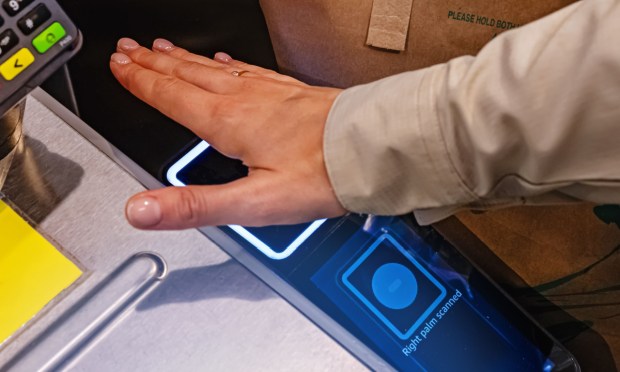Biometric Payments Provide the No-Touch Transactions Customers Want

The thing about technical innovations is that they tend to come in pairs.
Or at least work in concert together.
Generative artificial intelligence (AI) is increasingly being integrated across next-generation biometric payment channels, including facial and fingerprint verification, palm screening and even voice recognition, to increase speed, security and authorization rates while removing frictions along the payment journey for businesses.
Earlier this week, on Tuesday (Sep. 19), Amazon announced it was integrating radio-frequency identification (RFID) tags into its biometric-first Just Walk Out retail stores in order to make the consumer experience for soft goods equally as frictionless as it is for packaged ones.
The eCommerce giant first piloted the soft-good RFID tagging feature for a few games at the end of Seattle Kraken’s ice hockey season earlier this year in Amazon’s hometown Climate Pledge Arena, in Seattle, Washington; and will be rolling it out for the NFL’s Seattle Seahawks 2023-2024 season at Lumen Field Just Walk Out stores.
So how does it work? For customers, they just pick up their goods and walk out.
It’s on the back end where the magic happens. The biometric stores are powered by a winning combination of computer vision, object recognition, advanced sensors, deep machine learning models, and generative AI that keeps track of both customers and their purchases to charge them using tap to pay debit or credit options, or Amazon One’s biometric palm recognition device.
Following the success of last season, where the Seahawk’s home turf Lumen Field saw transactions per game increase 85% and total sales per game increase 112%, the stadium added eight more Just Walk Out stores — making it the venue with the most checkout-free locations in the world, all powered by AI orchestration.
Read also: Generative vs Predictive AI’s Role Across the Future of Payments
Biometric Authentication in Payments
Customer expectations have been retrained around convenience and speed when it comes to payments. No more is waiting 30 seconds for a card to settle acceptable — in fact, many consumers would rather not wait at all.
And as these behavioral expectations become status-quo needs, it is becoming more and more important for businesses to deliver a seamless and engaging transactional experience.
Already, restaurants and other high-frequency retailers are competing to offer in-person experiences that are as frictionless and seamless as the online transactions key customer bases are accustomed to.
As reported by PYMNTS, Panera Bread on Wednesday (Sep. 20) introduced a new feature allowing customers to order with just one swipe.
Restaurants in particular are competing to offer increasingly frictionless digital experiences, with many brands implementing innovative and convenience-centered technologies such as in-car ordering through vehicle dashboards and even voice-assistant ordering through smart home devices.
It is not just restaurants and sports stadiums, either.
J.P. Morgan is testing biometric-based payments at some U.S. retailers, while other financial institutions are leaning into biometric payment cards for enhanced security and an improved user experience.
After all, making things easy is just good business. Recent PYMNTS Intelligence finds that consumers now see biometrics as the most secure method for transaction authentication, and this represents the preferred authentication tool for more than half of U.S. consumers.
Meeting Customer Expectations
When PYMNTS sat down with John Miller, the CEO of facial verification technology firm Pop ID last year, he explained that although smartphones are where biometrics have gained the most popularity with consumers so far, “our goal is to be like Apple Pay, except without the phone.”
And the company is making strides in that direction, inking a partnership this summer (June 23) with casual dining chain Steak ‘n Shake to integrate its pay-by-face capabilities across up to 300 locations.
That’s because generative AI technology is helping biometric recognition software do its job better, faster, more securely and at scale.
This is happening when the intersection of available and non-cost prohibitive technology is being increasingly aligned with evolving customer expectations around payment choice and ease.
Meeting those expectations can ultimately mean an improved, differentiated, and frictionless customer shopping experience, or a great shovel for digging a competitive moat.

